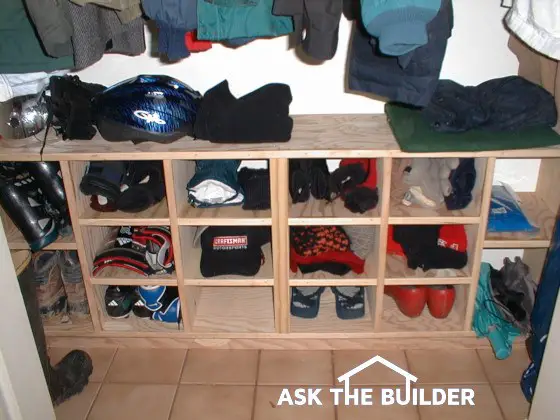Shoe Storage

DEAR TIM: The bottom of my closets are a mess. Shoes, boots and who knows what live down there. I'll bet you provided shoe-storage solutions in the houses you built. How can I solve my messy problem and maximize the floor and wall space under the hanging clothes in my closet? I have seen closet organizers in stores but would prefer a custom solution. Hollis B., Dublin, OH
DEAR HOLLIS: I think many people have the same clutter problem that you are dealing with. In fact, I just solved a similar problem in my own mud-room closet. Using scrap plywood and several hours of time, I made a cool shoe storage bin. I have built many closet organizers over the years for customers and finally did one for my wife. As you might imagine she is happy to see the closet floor once again.
I decided long ago that closet storage problems could be solved using the same methodology that can be found in old fashioned roll top desks. The pigeon hole system found in these pieces of furniture maximize the vertical air space that rises above the back surface of the desktop. Expand the size of the pigeon holes for a closet space and you can store just about every hard or soft clothing item that you own. The trick is to make the organizational slots the right size. The goal is to fill the space between the floor and the clothes with as many slots as possible but make them large enough so they can be accessed without banging your knuckles.
Over the years, I have found that a perfect closet cubby hole for shoes is one that is nine inches wide, six inches high and eleven and one half inches deep. These work for all standard shoes and slippers. Work boots, roller blades and other large footwear need a space that is at least ten inches wide and up to twelve inches high. The eleven and one half inch depth works for these but sometimes part of the larger item may project past the front of the organizer.
These closet cubby organizers should not be too tall. In fact, I always try to have the top of my organizer stop about eight inches below the bottom of the hanging clothes. The top of the cubby organizer acts as a shelf for boxes, helmets, or other miscellaneous items. It also saves on material and assembly time.
You need to think ahead when you build these systems. Because a typical closet has a door opening smaller than the inside width of the actual closet, you can't make one large unit and place it in a typical closet. The organizer needs to be two or more pieces that are mated together once inside the closet. The parts can be equal in size or one can be wider than the other. You simply need to make sure you can get each piece inside the closet.
I prefer to use scrap 3/4 inch plywood for these closet cubby systems. You can purchase fir or yellow pine plywood that has one or more good veneer faces. But even if one side is not so good, you will rarely see the imperfections once the cubby holes are filled with shoes, gloves, hats, etc. I use a thin piece of screen stop molding that is 3/4 inch wide by 1/4 inch thick to hide the coarse plywood edge of each divider. These need to be glued and nailed to the plywood edges.
You can use thinner material to make the closet organizer but it requires lots of skill to fasten the pieces together. If you nail into the side of a divider to secure a horizontal shelf piece, your nail may miss the narrow width target. If you own or rent a router, you can use a standard straight bit to create a handy mortise channel for each shelf to fit into the vertical dividers. This is how I assembled my closet cubby organizer.
The beauty of this system is that you can make different modules and stack them next to one another. If you have lots of smaller items to store perhaps one size slot will work for all items. Keep in mind that you must keep the space in front of the organizer free of items for this system to work. The purpose of the closet cubby is to allow you to see what you have and to allow quick and easy access to the items. If you start stacking things in front of the organizer, you will be no better off than you are now.
Related Articles: Closet Organizers, Adding Closet Storage Space, Two Closet Plans - Materials, Two Closet Plans - Build
Column 388